Arizona's Sky Islands are a 'treasure' that warming climate and mining threaten to bury
SUMMERHAVEN — When there’s snow on the mountain, an only-in-Arizona party breaks out.
It’s Southern Comfort and Krispy Kremes for a birthday party around a forested picnic table on this island in the sky with its views plunging 6,000 feet to the drab expanse of desert scrub and saguaro cactuses below.
It’s road cyclists in polyester shorts ending their grueling ascent from toasty Tucson with a selfie atop a snowbank, a hint of marijuana smoke wafting past them from somewhere in the village of weekend cabins while a snowboarder leaps off a berm at Ski Valley in the background. Sometimes a coati, a javelina or a roadrunner shows up in the parking lot. Ravens and jays patrol for untended snacks and scraps.
And it’s a 5-year-old boy trudging up a small hill and sliding down back down on a plastic toboggan, while kids from the neighboring Mexican state of Sonora stream out of family cars and squeal as they dodge snowballs and touch their tongues on the frozen flakes.
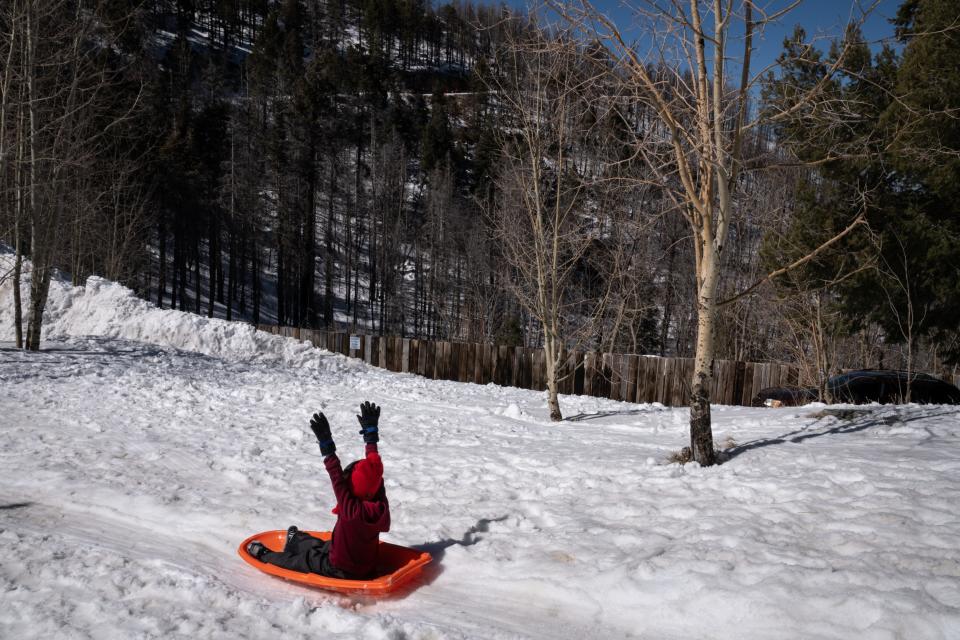
“It’s easy for us to travel 45 minutes to come to a whole different world,” Tucson resident Jordan Reed said while watching her son sled atop Mount Lemmon during the remarkably snowy February of 2023.
In summer, when the city below is sweltering, the granite peak in the Santa Catalina Range offers cool respite. “It’s amazing — probably a 20-degree improvement,” said Adam Smallman, a mining equipment trainer who travels from London to Tucson four times a year and needs an escape during the summer visits.
Mount Lemmon — Babad Do’ag, or Frog Mountain, to the Tohono O’odham people — rises in the Catalinas, one of 17 ranges in what is known as the Madrean Archipelago Sky Islands, a culturally and ecologically rich sprinkling of towering mountain ranges that rise from the desert. These ranges give beige southeastern Arizona a bouquet of otherworldly greenery, but with very worldly challenges. A warming climate is drying the forests, squeezing the rich web of life into smaller oases on these mountains, periodically chased by intensifying megafires.
For now, this remains a magical realm above the plains where the Sonoran and Chihuahuan deserts meet, where exotic green-and-red birds like the elegant trogon fly, where mountain springs float endangered frogs and feed the insects that feed Arizona’s cornucopia of hummingbird species. These mountains are where, occasionally, America’s rarest wandering cats, jaguars and ocelots, roam, and where state and federal biologists seek to recover Mexican gray wolves. They are also a mining zone long exploited by industry and now attracting a new wave of prospects as the emerging green energy economy demands raw materials.
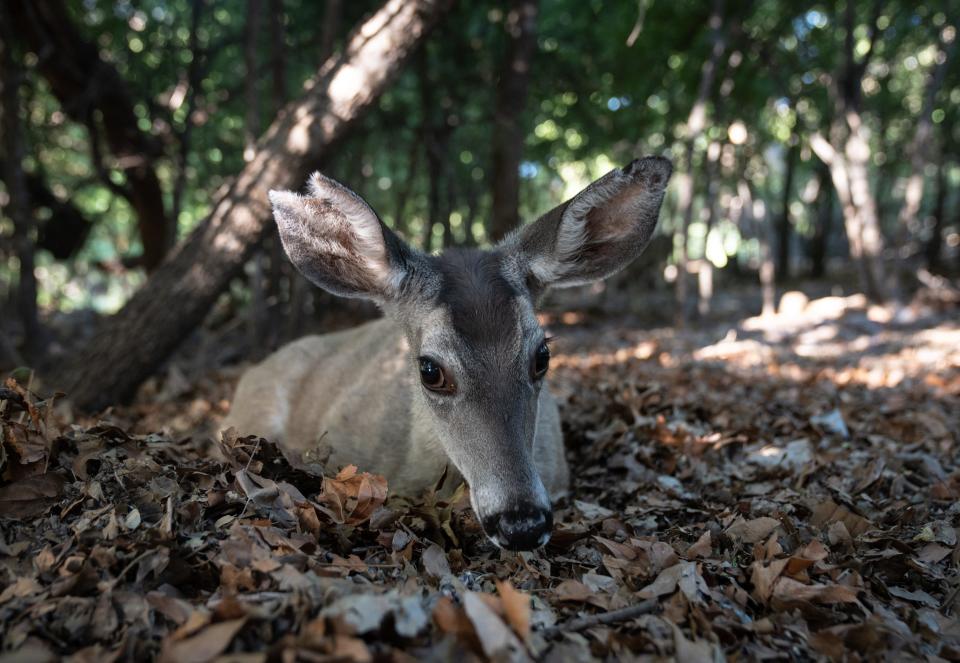
From the New Mexico Bootheel to the Santa Teresa Wilderness southeast of Globe to the Baboquivari Range crossing into Mexico on the Tohono O’odham Nation, Arizona’s Sky Islands are a landscape like none other in America. They provide a temperate environment distinct from the sun-baked flats, and act as a vital mixing zone for animals dispersing from the Rocky and Sierra Madre mountains to the north and south.
Birds that hew to the Gulf of California and the Pacific Coast on their springtime migrations to the north veer inland on their way back south, attracted by nectar and clouds of insects that arise after Arizona’s summer and autumn monsoon rains, a sort of second spring unique to the region. As lowland areas to the north and south warm, the mountains provide cooler zones for mammals and plants whose ranges must shift with the temperatures.
Already situated precariously at the edge of habitable ranges for many animals and trees, these mountains are like points in a dot-to-dot drawing of the Southwest’s ecology. Rising temperatures, highly flammable non-native grasses and development pressures all hang over them as erasers ready to break the chain. The rapidity of change leaves some scientists wondering whether nature may need assistance in adapting, such as with the planting of tree species currently more common to the south.
“These Sky Islands act as stepping stones between those Rocky Mountains and the Sierra Madres, between the tropics and the temperate (zones), between deserts and everything around,” said Bryon Lichtenhan, stewardship specialist with the Sky Island Alliance, a Tucson-based group dedicated to protecting and restoring natural diversity of life in the region. “Even larger species ― bears and deer and things like that ― will roam hundreds of miles looking for new habitat and places like this where things are a little cooler, where there is more water to be found, where there’s food to eat.”
The mountains support most of Arizona’s 28 bat species, including a canyon in far southeastern Arizona’s Chiricahua Range where biologists capture and study at least 20 of them, many as seasonal migrants from Mexico that perform critical tasks of pollination and cropland pest control around the continent.
“If you like margaritas, you gotta love nectar-feeding bats because they pollinate agaves,” said Tim Snow, a retired nongame biologist who helped train biologists on bat capture methods in the Chiricahuas last summer.
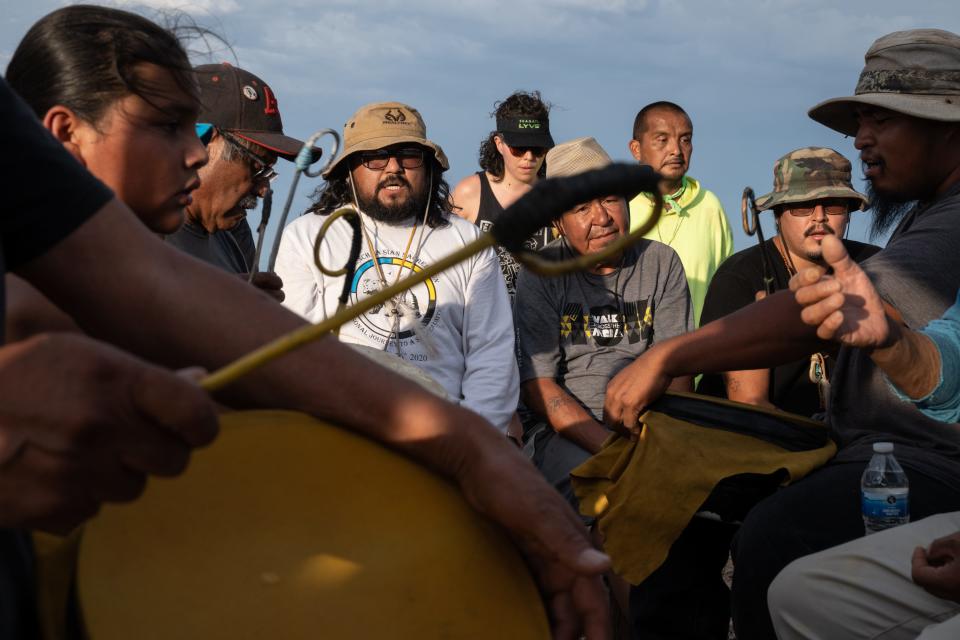
They’re places of spiritual renewal and reverence to some of Arizona’s Indigenous peoples.
“Mount Graham is just sacred,” a place from which life springs and upon which spirits like angels gather, said Wendsler Nosie, a San Carlos Apache activist who has long organized a yearly spiritual run up the 10,724-foot peak in the Pinaleño Mountains near Safford. “It’s one of the most powerful mountains in the Southwest.”
Yet Graham ― Dzil Nchaa Si’an, or Big Seated Mountain, in Apache ― also provides a warning of the ravages that a warming climate is aiming at the Sky Islands. A squirrel found only on this one mountain, the Mount Graham red squirrel, has teetered on the brink of extinction for decades, at one time thought to have already gone extinct but now numbering 144 at latest count. It lives in the cool of the mountaintop’s spruce-fir forest, with nowhere to go if recurring waves of drought and wildfire erase that stronghold. To bend the island metaphor to the squirrel’s perspective, Graham is less a stepping stone than a rock sinking under the rising sea of climate change.
Above all, the Sky Islands are a wholly unique and largely unheralded ecosystem that is itself endangered by rising temperatures that threaten to push pines, firs and the critters that live among them right off the mountaintops and into extinction.
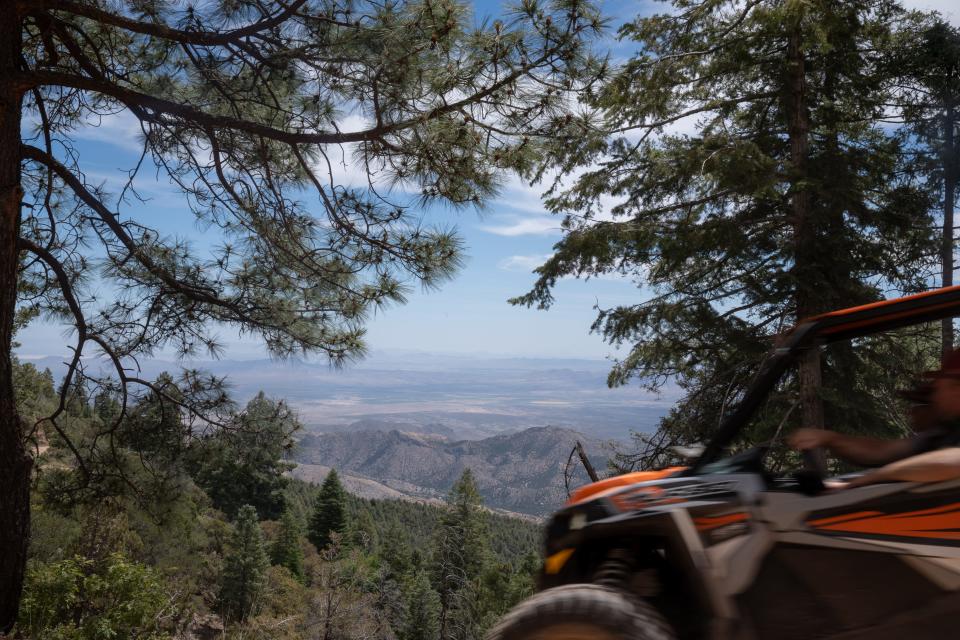
For the birds: How to find an elegant trogon
It’s easy enough to get under an elegant trogon’s skin and test his “elegance” during nesting season. Despite the male bird’s dashing, polychromatic suit of feathers — red breast, white collar, black cap, gray wings, green jacket with bronze tail — he sheds all grace when you hold a smartphone overhead and play a recorded trogon call into a southern Arizona oak and sycamore forest.
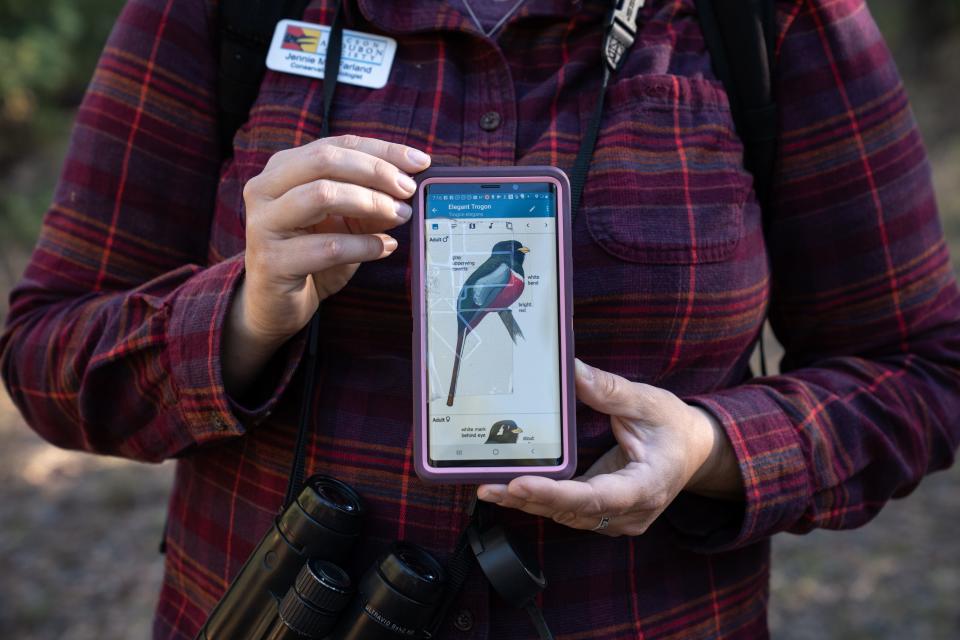
That’s how Jennie MacFarland tracks them down each May. The conservation biologist with Tucson Audubon leads the annual count, moving crews of volunteer birders from range to range by the week to track the population’s trajectory in the bird’s preferred elevations between 5,000 and 6,000 feet. On one such outing in the Patagonia Mountains last spring, she enticed a trogon pair into revealing themselves only moments after stepping out of her vehicle.
“Kwok-kwok-kwok-kwok-kwok-kwok.” Six throaty squawks from the phone alert the trogon to a challenger for his nesting turf. Within moments, the bird who has taken up residence swoops overhead to inspect the intruder, who turns out to be human. In this way, MacFarland and volunteers who spread out across the mountains can pinpoint where elegant trogon pairs are nesting.
It's a method she advises birders to forgo in popular trogon-watching locations such as Madera Canyon on the west side of the Santa Ritas, where too many people playing too many recordings around known nests could drive the birds bonkers. Where MacFarland played it, though, off a dirt forest road deep in the Patagonias, it was the only sound besides the rustle of windblown oak leaves.
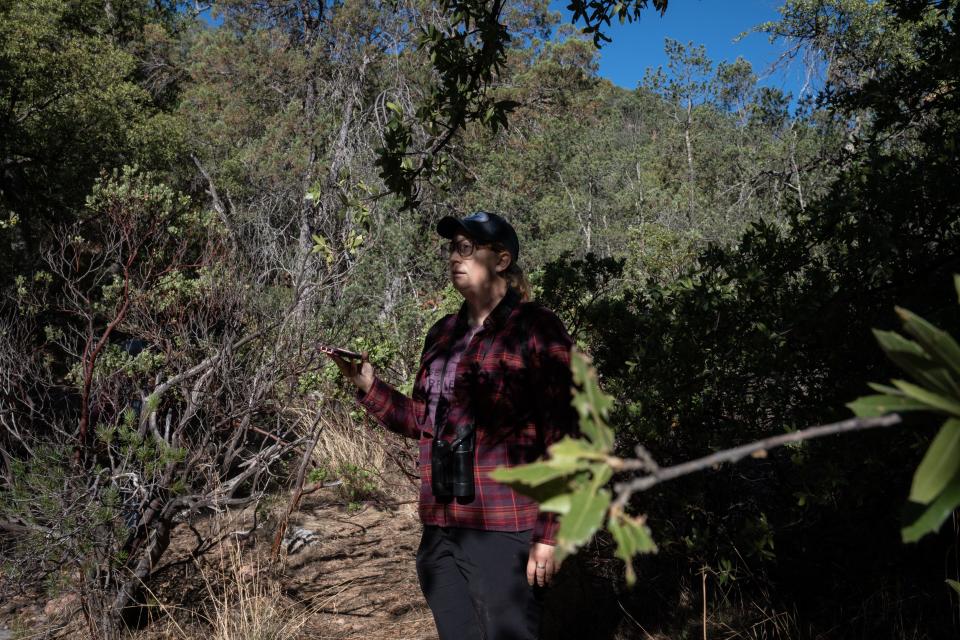
Trogons frequently nest in the cavities that develop in sycamores when the trees drop limbs in a sort of self-pruning job, MacFarland said. For this reason, birders tend to flock to the wetter Sky Island canyons where sycamores thrive, such as Madera Canyon. But trogons like those that she found in the Patagonias are equally at home in cavities that woodpeckers drill out of oaks, she said.
The Patagonias, trending north from the U.S.-Mexico border near Nogales, join other Sky Islands like the Santa Ritas, the Atascosas, the Huachucas and the Chiricahuas as the northernmost redoubts of these mostly Mexican birds. The mountain ranges offer bountiful expanses of what the trogons need, MacFarland said: oak and sycamore tree cavities for nests, and a smorgasbord of insect life that erupts from both winter and summer rainy seasons.
As if to prove the point, a butterfly — specifically, an Arizona sister — flitted among the manzanita underbrush, flashing bright orange spots from the tips of its dark wings.
The birds feast on grasshoppers, katydids, walking sticks and various caterpillars. The name trogon means gnawer in Greek, and the birds are often photographed with grasshopper legs jutting from their beaks.
Earth’s warming climate is especially pronounced in the West, and is creating an uncertain outlook for Arizona’s trogons. Climate scientists have linked the region’s prolonged drought since 2000 to hotter temperatures. The full-year average temperature in the Sky Islands region of southeastern Arizona has warmed by 0.6 degrees Fahrenheit per decade since 1970, according to National Oceanic and Atmospheric Administration data.
The Sky Islands are projected to become drier, MacFarland said. Recent drought years with poor monsoon seasons provide a glimpse into a future where trogons may go the way of the thick-billed parrot, a pine nut-eating species that lived in Arizona pine forests through the early 20th century and again briefly in the 1980s and 1990s after an ultimately unsuccessful reintroduction, but that now clings to lusher sections of Mexico’s Sierra Madres.
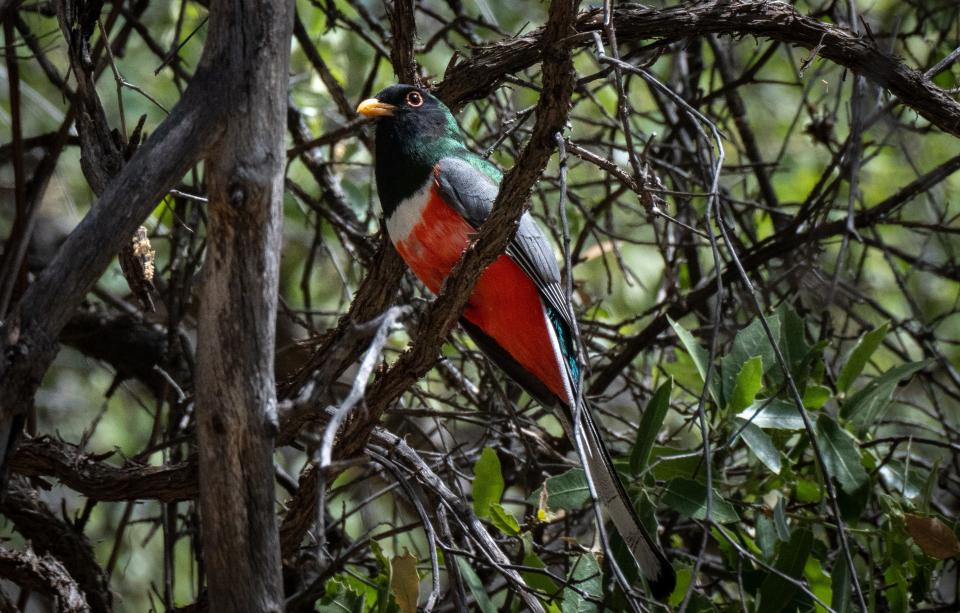
The 2020 bird census logged a record high of 201 trogons in Arizona’s Sky Islands, with the highest concentration in the Huachucas. Then came the driest year on record, MacFarland said. “These trees looked so brown and crunchy,” she said. Migrating trogons started moving north in spring but likely stopped or turned back when they saw the local conditions. That year’s count dropped by two-thirds, to 68.
Mearns quail, the masked game birds also known as Montezuma quail that frequent the oak savannas ringing Sky Island ranges, also crashed that year, MacFarland said.
Heavy monsoon rains followed, helping the 2022 trogon count rebound to 121. Another healthy monsoon followed, and then a wet winter.
“The territory looks good,” MacFarland said during her 2023 Patagonia outing. That count would again show a bump in birds, to 183 across the Sky Islands.
The dramatic yo-yo effect shows how quickly things can change for wildlife at the edges of their native range when conditions worsen.
“It’s always on the edge where things change most, right?” MacFarland said. “And we’re right on the edge” of trogon range.
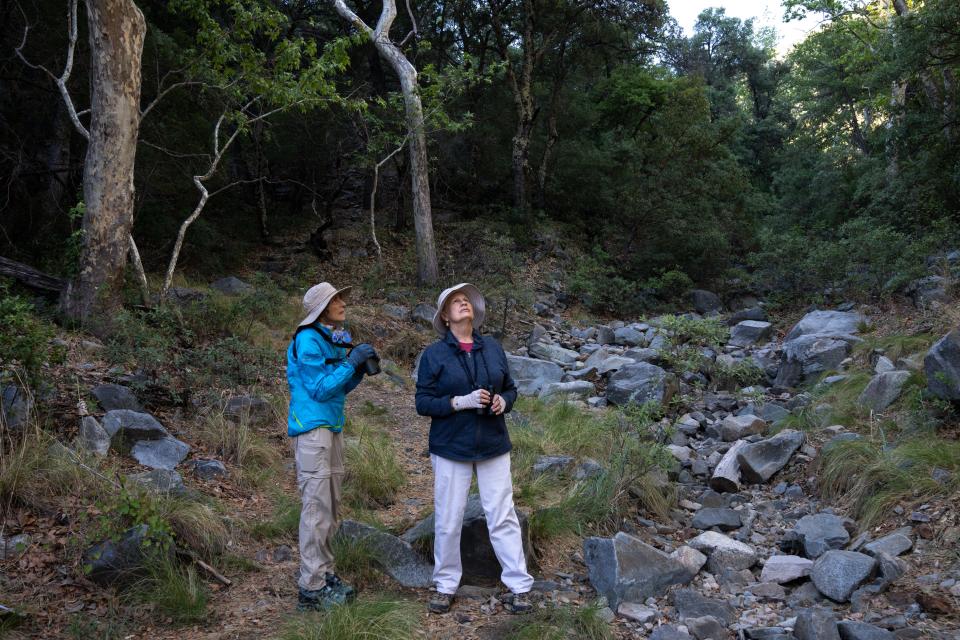
Farther north last May, at Madera Canyon, birders from around the country traipsed the rocky trails and sat quietly for hours, training camera lenses on sycamore cavities, waiting as male and female trogons took turns returning to or emerging from them. Some had traveled from as far as Minnesota specifically to scratch the trogon off their life list of bird viewings. These birders are a major driver of a billion-dollar wildlife-watching industry in Arizona.
The Arizona Game and Fish Department in 2018 produced a report using 2011 figures to estimate that 1.6 million people watch wildlife in Arizona, and that each spends nearly $600 on average to do it. The wildlife viewing that is dominated by birders in the Sky Islands region is thought to generate at least $300 million a year, according to Tucson Audubon.
“This is on the route,” part-time Tucson resident Keith Wiggers said before heading up the trail toward a Madera Canyon trogon nest. “(For) anyone traveling internationally or through the U.S., this is a must stop.”
Wiggers, a retiree in his late 70s, is a hardcore nature fan. On the drive into Madera Canyon, he picked up a roadkill jackrabbit and brought it to the trailhead parking lot, where he took it out of a garbage bag that he keeps in the car for such occasions and started flicking ants from it as cleanup for the ride home. It would serve as bait for scavengers. He posts wildlife videos to YouTube, including one showing a vulture tug-of-war match with a roadkill snake.
Trogons are one prize awaiting birders at Madera Canyon, but not nearly the only one. Wiggers has been visiting since the 1980s. On the previous day, he had counted 21 bird species, including flycatchers and Scott’s orioles.
The Sky Islands are “a treasure” of biodiversity, Wiggers said, but also a spot at risk from both climate change and mining, a threat that appears to be growing specifically because the nation needs copper, manganese and other minerals to produce a cleaner, climate-friendlier energy future. Human encroachment is pressuring nature here as everywhere.
“It just makes you literally cry sometimes,” Wiggers said.
Forests on the edge: 'It felt like the world was burning'
The summer of 2020 was extra hellish for Tucson residents. As usual, the summer heat had ramped up ahead of the cooling from expected seasonal monsoon rains that never fully materialized. By June 4, the city broiled at 108 degrees.
This was the same record-dry summer that repelled elegant trogons across Arizona’s Sky Islands, and Tucson would end the year with just over 4 inches of rain, far less than the average of more than 11. In the city, residents with air-conditioned homes stayed inside, confined by both the stifling heat and the fresh horrors of the COVID-19 pandemic.
On June 5, a storm chaser captured video of a massive lightning strike in the Catalinas that soon would wind the lockdown more tightly. The combination of drought and invasive, highly flammable buffelgrass would toast Tucson’s Sky Island playground, Mount Lemmon. It was the second time a massive wildfire had traumatized Summerhaven since 2003, when the Aspen Fire torched more than 300 dwellings there. This time, the Bighorn Fire would not destroy buildings, but it would burn uncontained for 45 days across 120,000 acres, again forcing the village’s evacuation.
The chilled mountain oasis, usually so close at hand, would elude a population yearning for fresh air.
“It just felt like the world was burning,” said Katie Herder, a public health graduate student at the University of Arizona and a former Peace Corps volunteer.
Almost a year and a half later, in November 2021, Herder ascended the mountain with a crew of Sky Island Alliance volunteers who fanned out to find and assess the ecological health of springs that sustain plant and animal life and contribute to Tucson’s streams and groundwater recharge. She and two other women were assigned Mint Spring, a spongy trickle through the grass on an otherwise dry ridge behind Summerhaven. Fragrant and refreshing mint sprigs surrounded the narrow ribbon of wet grass, a blanket of green on the brown landscape under the blackened totems of charred ponderosa pines.
Arizona has more identified springs than any U.S. state, whether because they’re easier to see in deserts and savannas or, the Alliance’s Lichtenhan suggested, because they’re so critical to life here and therefore worth mapping. The Alliance has mapped thousands of them in the Sky Islands and assesses their ecological function to prescribe interventions for those at risk of drying up.
Herder and fellow volunteers noted the running water’s width, the depth of more than a foot at the point where the spring emerged from the mountain, and the condition of plants. All looked reasonably healthy, if denuded of tree and shrub cover. Their report would inform the alliance’s decision to plant shrubs there to provide shade and erosion control.
“Climate change is bringing larger and more intense wildfires to the Sky Islands, which is particularly an issue because these mountain ranges are isolated,” Sky Island Alliance Executive Director Louise Misztal said. “When a large fire burns in a mountain range like the Catalinas, a large portion of that high-elevation forested habitat can really be destroyed and altered.”
Finding and protecting or restoring springs that could be eroded and clogged by silt is important to both wildlife and people, she said.
So close to urban Arizona, Mount Lemmon offers high-visibility snapshots of how climate warming, drying and fire threaten the state’s southern mountain forests. It is by no means the only troubling example.
Another fire, this one of undetermined human origin, broke out in the Chiricahua Mountains of far-southeastern Arizona on May 8, 2011, and may have forever altered the range that includes Chiricahua National Monument.
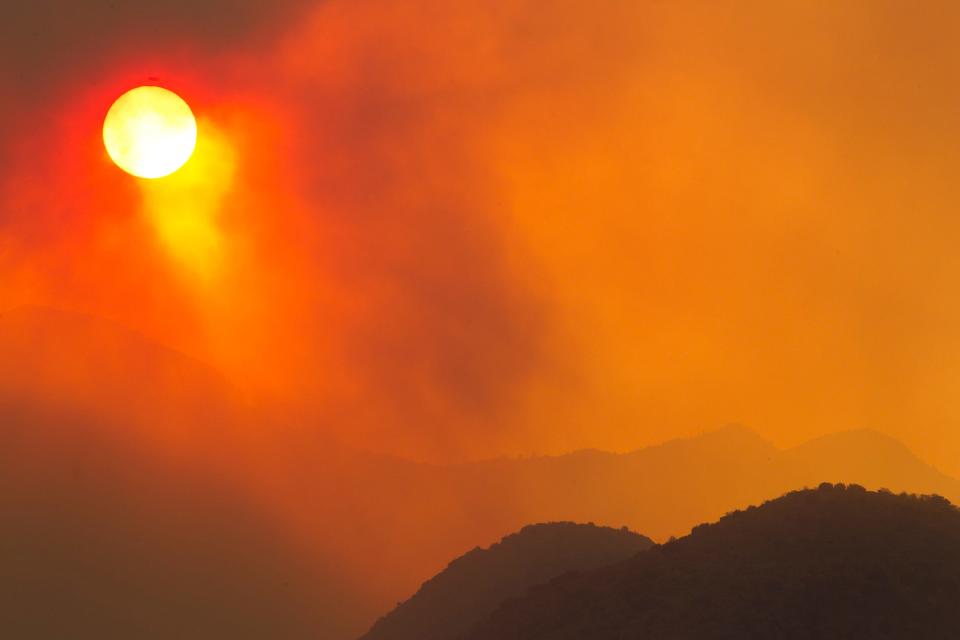
The Horseshoe 2 Fire, named for its canyon of origin, blasted more than 200,000 acres, much of it oak-pine woodlands that researchers believe will now favor the oak at the expense of the pines.
“Anything that’s capable of sprouting seems to be doing just fine,” said Helen Poulos, a Wesleyan University plant ecologist who studies Sky Island changes with research partner Andrew Barton from the University of Maine at Farmington. They found that the intense burning from 2011 has favored oaks, which regenerate from the roots and shade out seed-dependent trees like pines. “That’s why these pines under climate change aren’t coming back as well.”
Nowhere is this more apparent than at Cave Creek Canyon, a popular birding destination near Portal. It’s now wall-to-wall oaks, Barton said. That may be fine for some birds, but the full complement of species may never come back. A bird like the Mexican spotted owl, which favors old growth with nesting cavities, could be among the casualties. An endemic species, the Chiricahua fox squirrel, declined in the national monument after the fire, Barton said.
The two researchers are relieved to see pines persisting in some of the monument’s cooler and wetter drainages, where the fire slowed and lost intensity. Maybe those areas can serve as refugia for pine-dependent species, and as seed banks for the future.
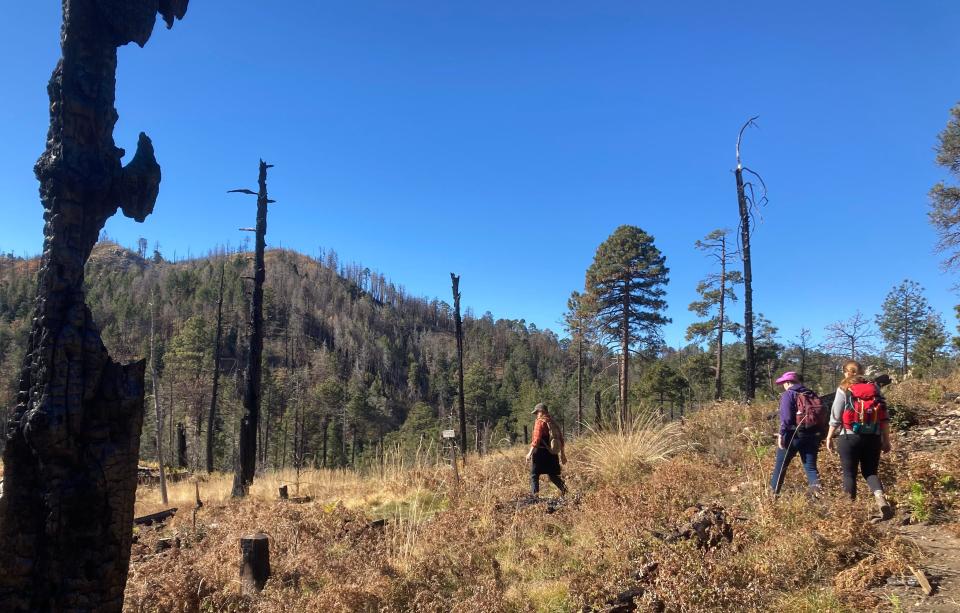
But will a warming and drying climate continue to chip away at Sky Island pines till they’re all gone?
“That’s a hard question to answer, and a scary question,” Barton said. A lot is riding on whether and how quickly the world ameliorates its climate-warming carbon pollution. “It depends on whether humanity gets its shit together, so to speak.”
The researchers noted that some scientists are building a case for planting other pine species from warmer parts of Mexico, such as the Chihuahua pine, in Arizona’s struggling ponderosa ranges. Doing so would replicate the natural work of jays and squirrels that would disperse the appropriate seeds if they had thousands of years in which to do it. That’s time that these ranges don’t appear to have under rapidly warming conditions.
“The climate is shifting faster than the species can move on their own,” Poulos said. “The bears and the jaguars and the coatis move in between (mountain ranges), but it’s harder for plants.”
The key, Poulos said, will be to identify the moistest, coolest canyons and slopes and concentrate any pine retention efforts there. The same could be true for other conifers in the Sky Islands, such as the spruce-fir landscape that supports the endangered squirrels on Mount Graham. Threatened Gila trout also face an uncertain fate there, as a 2017 fire forced a fish evacuation for safe keeping at a New Mexico hatchery before volunteers could return them once deadly ash had dissipated from the streams.
Nature's helpers: Doing the work to protect the land
One Saturday last June, the Sky Island Alliance’s Lichtenhan led a crew of volunteers up Mount Lemmon to move a bunch of rocks. Their hands were needed to help prevent further erosion that could wash away a pine- and alder-shaded wildlife oasis called Caseco Spring.
The area was damaged in the 2020 Bighorn Fire, and since then water has cascaded over formerly vegetated slopes, especially during big monsoon storms. The U.S. Forest Service, which controls much of the Sky Islands landscape within its Coronado National Forest, provided funds for this and other spring restorations.
Caseco Spring emerges just downhill from where motorists and cyclists make their way up the Catalina Highway to Summerhaven. The crew arrived there to find a 5-ton pile of lunchbox-size rocks sold under the label “Coronado Brown” by a Willcox quarry. They gathered at the pile for instructions on moving them by wheelbarrow and then dumping them down a slope before placing them by hand as little check dams and bowls.
“These rocks were dropped off on Tuesday, so hopefully they’re not full of snakes,” Lichtenhan said. He also warned the volunteers to watch for scorpions in the cracks.
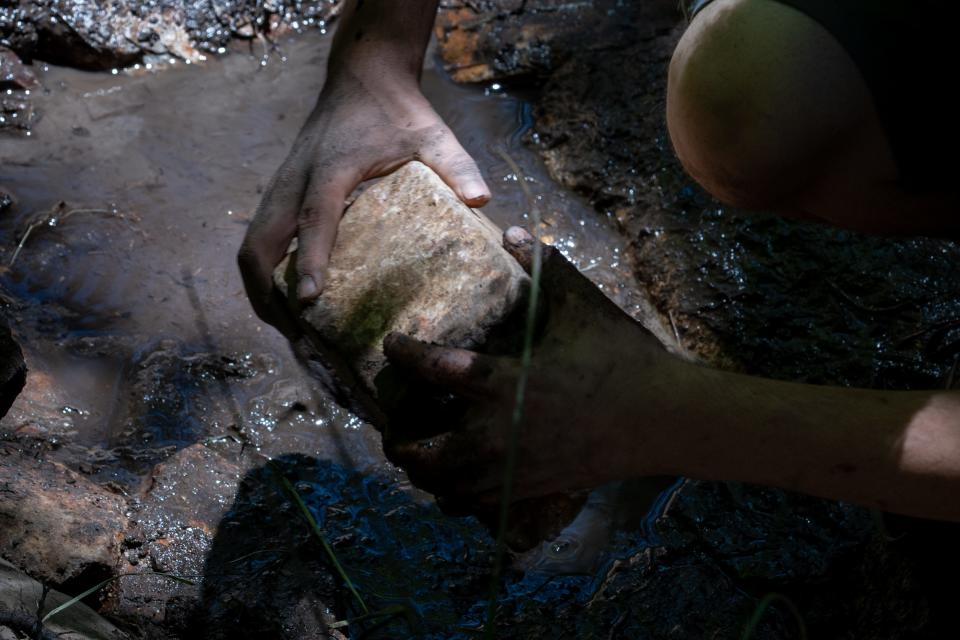
The volunteers eagerly started plucking and heaving the rocks down to the grassy seep, where Tucson resident Stacy Goodrich soon had her two teens, Kameron and Riley, pressing rocks into the mud.
“I’m just trying to get the idea in their heads to be actively involved and take care of everything,” Goodrich said. The family enjoys the outdoors, and nowhere more so than in the Sky Islands. “I’ve been in the desert for 30 years,” she said, “and (Mount Lemmon) is just so unique. There’s so much biodiversity, and it’s such an oasis for the people from Tucson to escape to.”
“I’ve always enjoyed nature,” 13-year-old Riley said. “Kind of an outdoorsy kid.”
They anchored the rocks against a boulder to create the first of three dams, each a single rock high, that will prevent floodwaters from downcutting when flowing against or over the boulder.
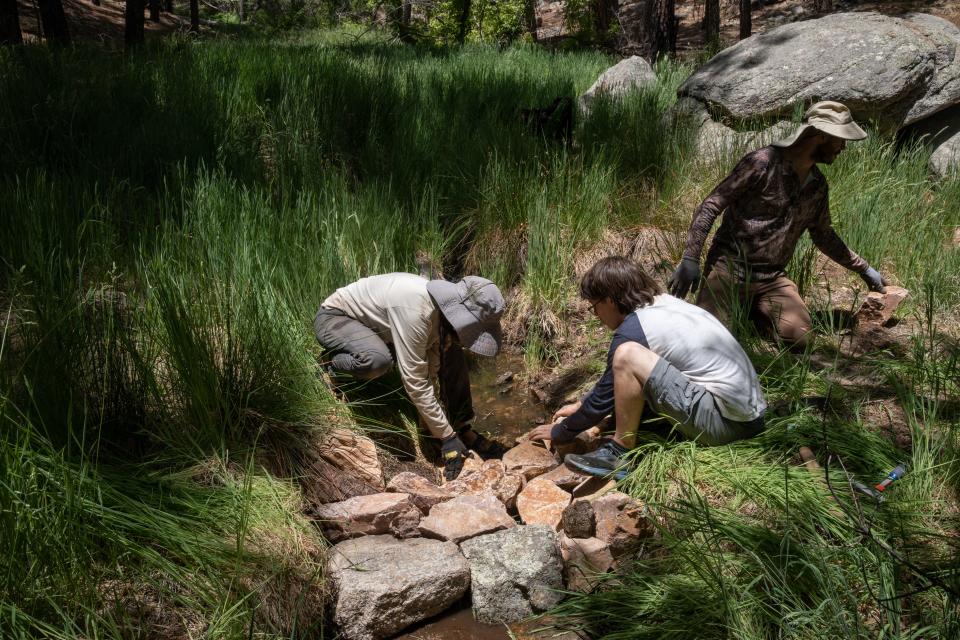
When the Alliance returned in October to see how their structures held up against the monsoon rains, they were still in place and starting to gather sediment, said the group’s habitat conservation manager, Sarah Truebe. “So that was very exciting to stop the incision that was happening in that drainage.”
Truebe leads the “Spring Seeker” program that maintains an online database of conditions at current and historic but sometimes damaged and dried up springs. The program has documented more than 900 springs with flowing or standing water within Arizona’s Sky Islands region, 75 of them with moist ground only, 55 that are dry but still vegetated, and 272 that have dried completely. Counting those that the volunteers haven’t reached, Truebe said, the Sky Islands region is known to have some 4,000 springs.
These springs and the snows and rains that refresh them are sources of the water that flows from mountaintop to the desert and then under the sand, bolstering the aquifers that communities including Tucson draw from and giving life to waterways critical to native species and migrating birds.
Water from one face of Mount Lemmon, for instance, might flow through Sabino Canyon Recreation Area on Tucson’s north side, and from there into the city’s Tanque Verde Creek, which in turn swells the Santa Cruz River during wet seasons.
Seemingly minor changes can affect these desert rivers in big ways. In recent years, Tucson and Pima County upgraded sewage treatment and directed treated water toward Santa Cruz restoration flows. The result: Partners including the state and the Sonoran Institute have transplanted endangered Gila topminnow into a stretch of river they had long abandoned. The little fish provide Tucsonans a personal ecological service as, according to Arizona Game and Fish, topminnows consume mosquito larvae that would otherwise grow to suck their blood.
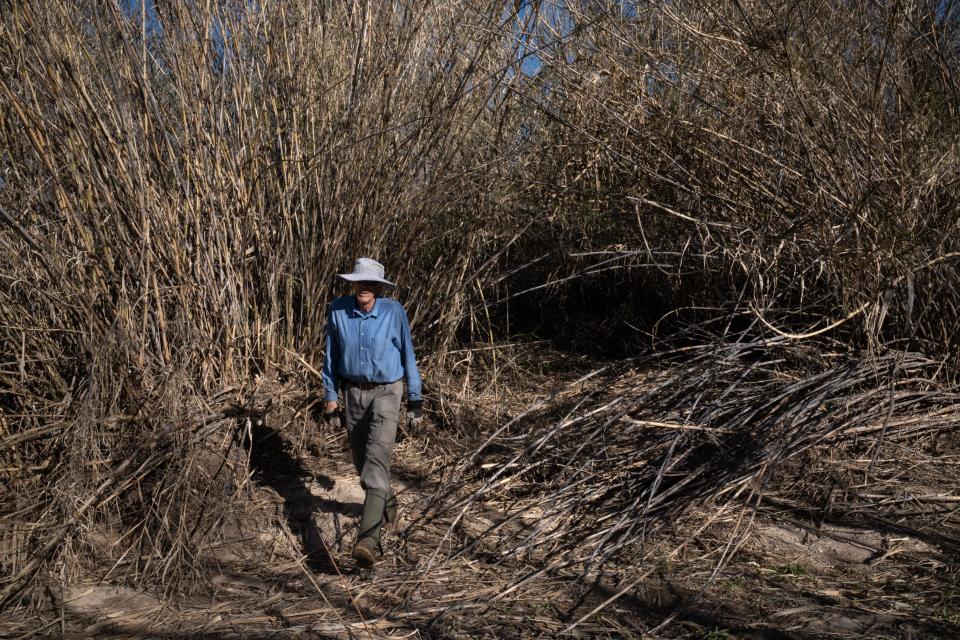
To maintain the restoration’s momentum, the nonprofit Watershed Management Group brings volunteers to streams where the mountains meet desert to remove tangles of non-native vegetation that sucks water and crowds out native species. In early 2023, one such target was Arundo, or giant reed, a bamboo-like plant that’s native to the Tigris and Euphrates rivers but now grows dense, reedy walls along Arizona streams.
Arizonans plant them for ornamental purposes, and volunteers said they see Arundo around Tucson, in yards and at subdivision entries. When monsoon floods snag roots or green shoots, the roots plant themselves and sprout wherever they find a trickle of flowing water. The matted thickets crowd out cottonwoods while also draining flows that might otherwise reach the Santa Cruz or sink to replenish groundwater that neighbors pump for home use.
Fires stripped away vegetation that once helped slow the water’s mountainside descent, so there’s been plenty of flooding to transport these invasives.
“There’s an intimate connection between what’s going on up there and down here,” said James Washburne, a hydrologist who guided volunteers in removing the stalks by their roots in a stretch of Tanque Verde Creek flowing through northeast Tucson.

Washburne’s team had worked the streambank with heavy equipment before bringing in the volunteers. Canes lay in piles on their sides, ready for the volunteers to knock off dirt clods that otherwise would keep them from drying out, leaving them as a possible threat with the next flood.
Sounds easy, but it’s a lot of dirt. Arundo roots stretch a foot or so deep in normal conditions, but resprout higher up the stalk each time new sediment buries part of the plant. The bank had grown to 4 feet deep, so the earth mover had turned up 4 feet of soil and roots.
People who lived near the Tanque Verde 50 years ago will remember a stream that, with the possible exception of June, had at least a trickle in it all the way through town to the Santa Cruz, Washburne said. It has since gone dry for longer periods, largely because of all the wells people have drilled and pumped. There’s little that volunteers can do about that, but they can help restore native vegetation that helps slow and sink floodwaters so they can burble back up through the year.
The goal at Tanque Verde is a mesquite bosque to complement the taller cottonwoods that survive there. Even now, it’s a place for coyotes and javelinas, and for birds and birders. As volunteers worked last year, black phoebes and vermilion flycatchers darted around collecting flying insects above the streambed.
Kristina Solheim of Tucson is in it for the water and for a sense of accomplishment. She has worked as a teacher around the world, and now, in her 70s, she wants her hometown to have a sustainable supply of water.
“It’s gold,” she said.
Mountains that never sleep: Nightlife on the islands
Ultrasonic bat chirps filled the air on a June night in the Chiricahuas. Most of them would be inaudible to human ears but for the laptop that bat researcher Janet Tyburec had set on a truck’s tailgate to pick them up and translate them into a lower range. The laptop crackled like a Geiger counter, reporting unseen traffic overhead.
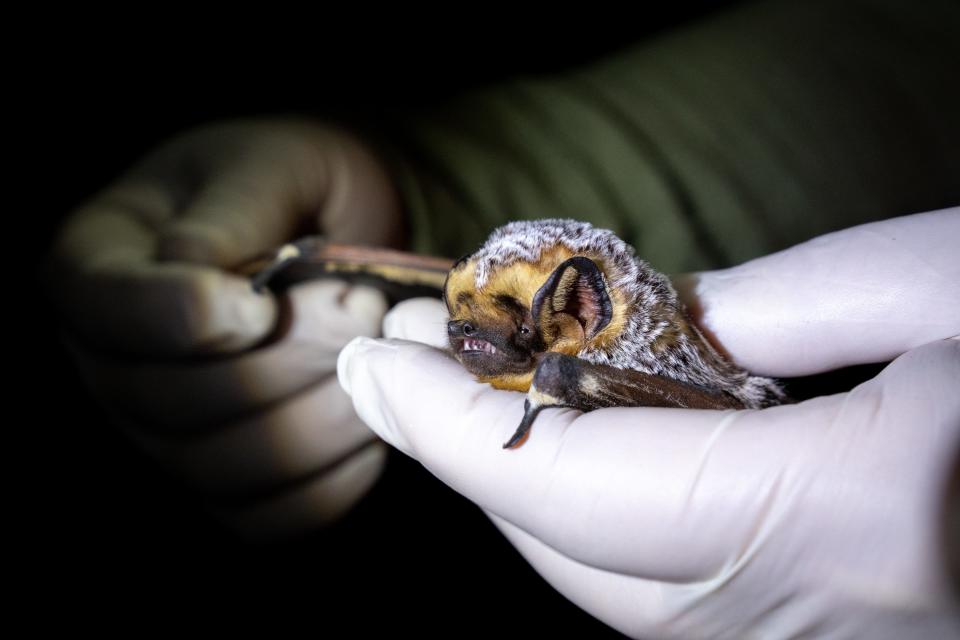
These mountain cliffs and forests are a vertical bat city in summer, with some species riding out the day in the craggy tree bark down low, others in rocky high-rise crevices and caves. At dusk they descend toward Cave Creek for a taste of the insects hovering just above the trickling water. Some species hang around through the night, while others shoot down the canyon and across the eastern flats onto New Mexico fields to gorge on farm pests.
“This is like their commute,” Tyburec said, “and this (canyon) is I-10.”
This busy flyway is where Tyburec led a group of biologists from around the country and Canada during a night of trapping and listening for 20 or so of the species that fly the Chiricahuas.
While all of Arizona attracts bats for at least part of the year, this is the mother lode. Some more or less hibernate here, while others migrate in seasonally from the Sierra Madre Occidentals or the Rockies. The roosting habitat and temperatures vary with elevation, and where there is water there are bugs galore. Species like the lesser long-nosed bat are pollinators that seek out cactus flowers in the surrounding desert.
“It’s like Walmart," Tyburec said, "because it has everything they need.”
She’s a bat surveying consultant based in Tucson and leads classes out of the American Museum of Natural History’s Southwestern Research Station in Portal. She does it along Cave Creek, she said, because the bats are so thick it’s like shooting fish in a barrel.
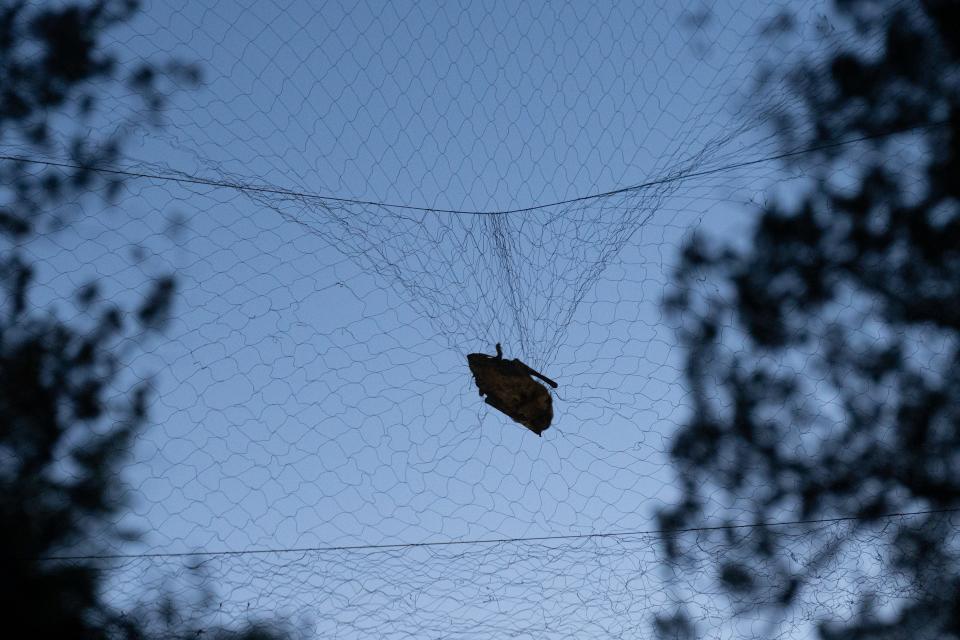
Students from federal, state or university departments spread nets like giant, gauzy badminton sets above the creek, waiting to do so until the birds go to bed and the bats come out.
They learn to use both nets and acoustics. Some of the species are either too wary of people or fly too high for trapping, but acoustics equipment can pick up their echolocation chirps, and the computer is programmed to identify the sounds by species.
Part of the crew sat quietly along the stream bank at 8 p.m., watching the nets. Others assembled around a table by the nearby road, waiting to weigh and inspect the bats for pregnancies before releasing them or, in a few cases, taking them up the road to the research station for a brief stay as participants in a study there.
At 8:10, students rushed to grab what they thought was a bat in the net, though it turned out to be a leaf. Five minutes later, a big brown bat (mouse-size, despite its species name) was the first to be trapped. Another, a pregnant female, followed at 8:25. Then a parade of bats commenced — big brown, freetail, Southwestern myotis, hoary — and handlers, all vaccinated, carried them to the monitoring table for a brief looking over. A hoary bat, named for the frosted tint on its fur, complained the loudest, and handlers were cautioned to use leather gloves because “those are bitey.” The bat calmed or tired by the time it reached the processing table before release.
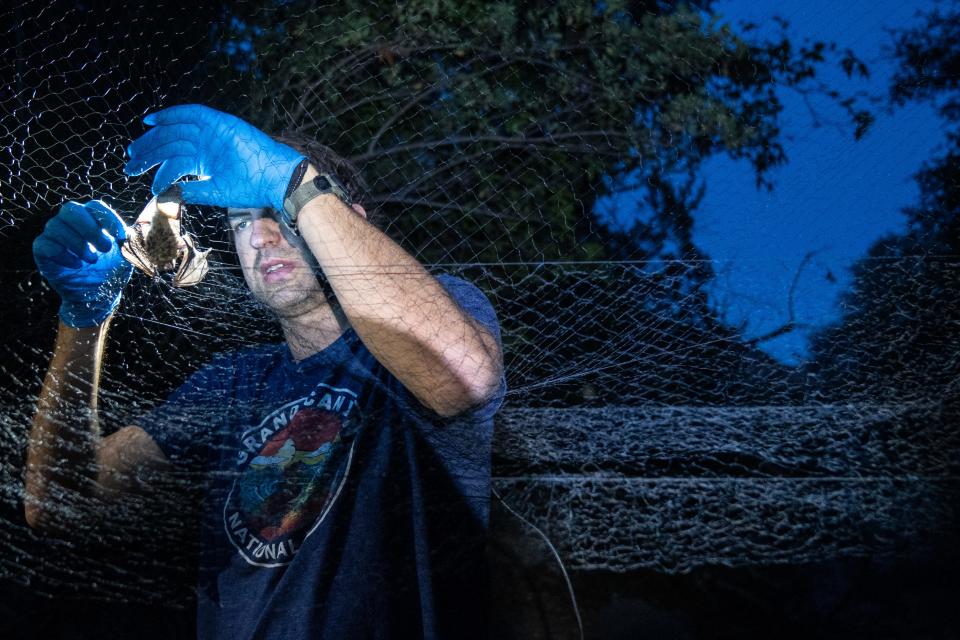
The Sky Islands don’t disappoint. Bats, like humans, are drawn to them.
“You just have these little pockets that are separated by the desert seas,” Tyburec said.
It’s not just bats and bugs that find refuge in the Chiricahuas. A few miles to the north of the bat class, Rick Taylor spends a lot of his time filling hummingbird feeders. One June morning, 10 them hung on trees above the lawn around his little house, a lawn he planted years ago only to give his child fair warning of any rattlesnakes that might approach from the surrounding brush. Normally, he said, he would have a couple more feeders up, but for now he had given up on trying to keep any suspended on his clothesline.
“The bear got the clothesline feeders by strumming the clothesline like a banjo string till they fell off,” he said.
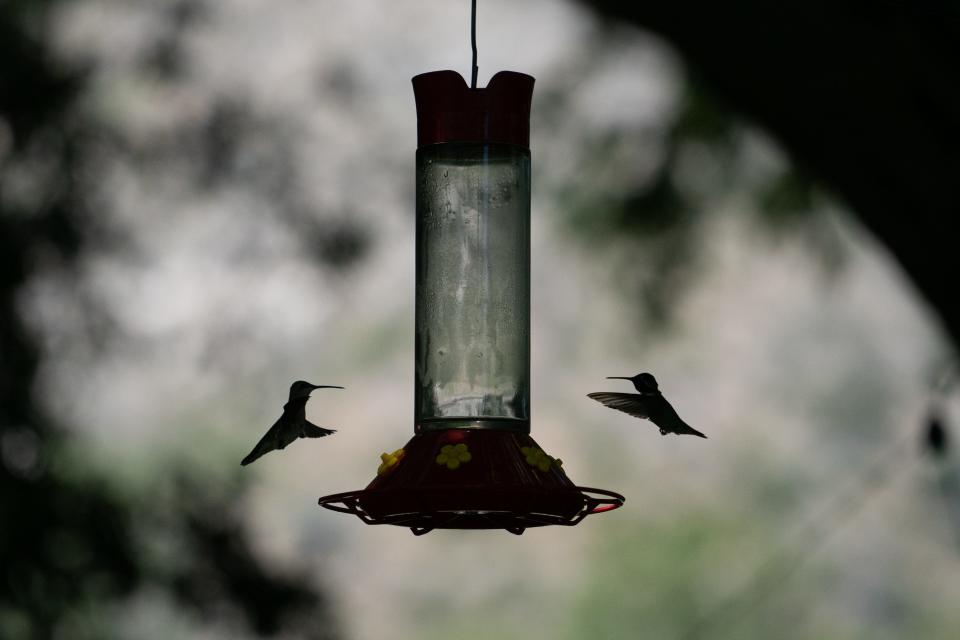
His home is definitely on the map for hummingbirds and for some astute hummingbird followers. Taylor is known to birders, having literally written the book on elegant trogons and begun the trogon census work that MacFarlane now continues with Audubon.
Word of his hummingbird feeders has also spread, meaning birders will file in along when the migrating hummers come through after monsoon rain. Some of the birds come from the Colorado Rockies. Some, including rufous hummingbirds, return all the way from Alaska.
“Thousands — literally thousands — will be using these feeders right here in the fall,” Taylor said.
It’s a big enough wave of both birds and people that the people around nearby Portal distribute hand-drawn maps showing which homeowners welcome respectful birders at their feeders and, by process of elimination, which would prefer solitude.
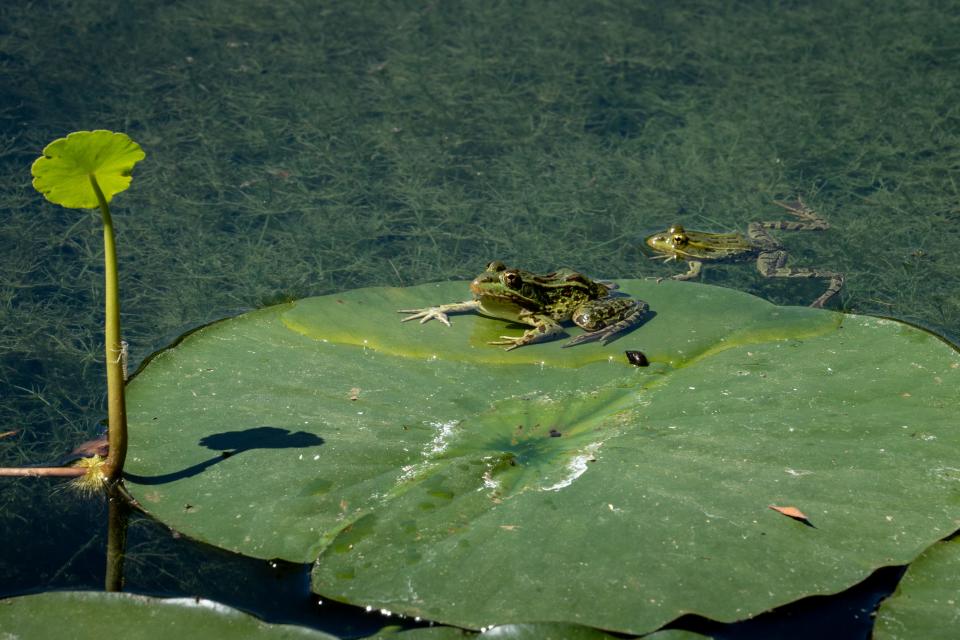
Biologists and conservationists have also built little frog ponds around the area to harbor endemic but endangered Chiricahua leopard frogs, replacing dried springs and creating enough distinct habitats to keep disease from spreading throughout the population.
“There are places that seem to be centers of energy,” said Taylor, who first came here decades ago as a fire lookout for Chiricahua National Monument, across the range’s divide from his current place. “Biodiversity is one of the indicators of that energy.”
The Chiricahuas, he said, exhibit greater diversity than most land-locked parts of the country. “I just loved it at first sight. I wanted to live here in the worst way.” He moved there in 1972.
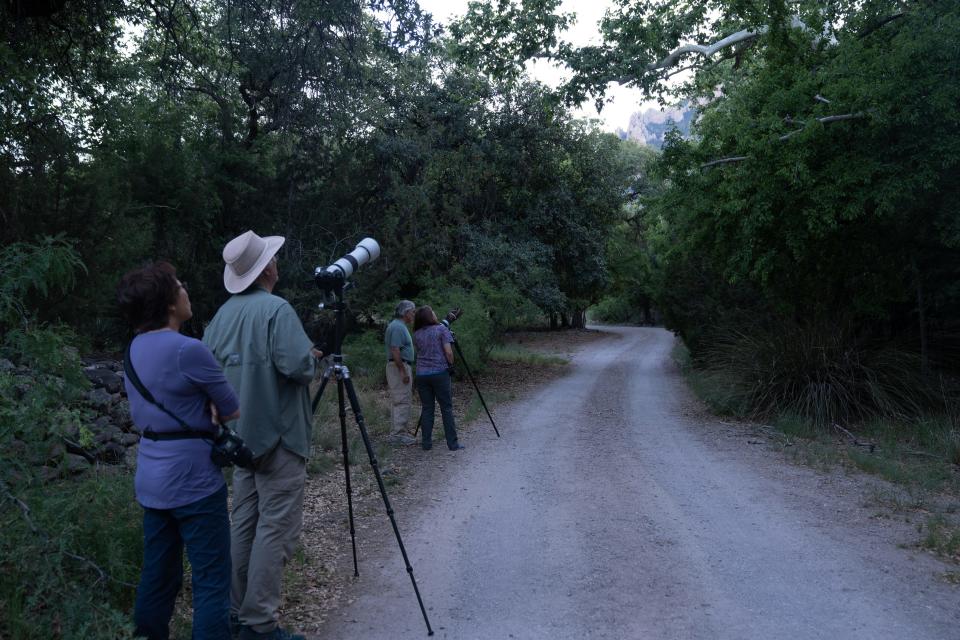
Taylor has led birding tours as far afield as Denali National Park and the Pribilof Islands of Alaska. For diversity, though, there’s no beating home, where he can see hundreds of species, including, once, a wayward Latin American long-billed hummer called a plain-capped starthroat, “the absolute unicorn of U.S. hummingbirds.” (According to the U.S. Forest Service, there have been fewer than 20 such sightings in Arizona.)
Tropical birds show up more frequently these days, which Taylor attributes to the warming climate. That’s fun, but also troubling. Other birds that he’s used to seeing every day may depart for points north. He saw Horseshoe 2 burn much of the Chiricahuas. Each year, he worries drought will wreck local nesting success.
“We have to slow and, if possible, reverse climate change, not just for the sake of humanity, but for the sake of human beings having the opportunity to experience nature,” he said. “It’s everybody’s heritage.”

Making connections: How new mines could alter landscapes
If the Sky Islands are to remain stepping stones for species on the move, they’ll need to retain unfettered pathways through and between the mountains. Roads, intermittent border fences, dewatered streams and thickets of invasive weeds all clutter the landscape. The most visible and audible complication, though, comes in the form of a renewed mining boom in the region.
“What’s happening is an onslaught of continuous, nonstop noise that simply will not stop for seven years,” Earthjustice attorney Scott Stern told judges on a panel from the 9th Circuit Court of Appeals in March when seeking to shut down exploratory mineral drilling in a canyon of the Patagonia Mountains. “That noise is so pervasive and it’s going to so interfere with the owls’ auditory processing that they won’t be able to hunt, they won’t be able to feed themselves.”
His argument: Officials with the Coronado National Forest should not have authorized drilling in a canyon that the U.S. Fish and Wildlife Service has designated as critical habitat for federally protected Mexican spotted owls.
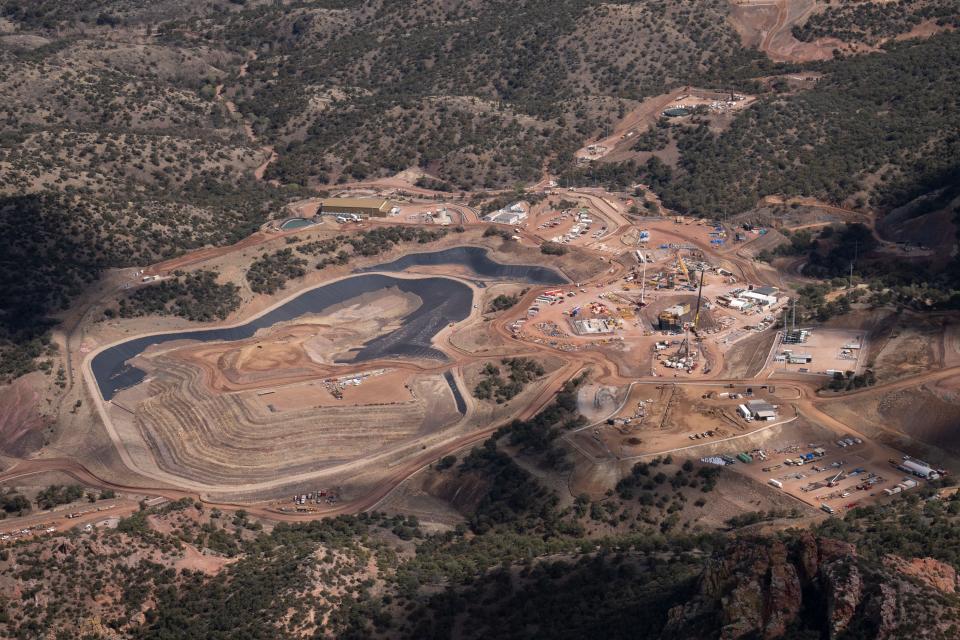
That’s especially true at Sunnyside, which is just across a ridge from a major zinc and manganese mine now in development, Stern argued. Plaintiffs including local environmental groups like the Patagonia Area Resource Alliance and Save the Scenic Santa Ritas say the Forest Service failed to consider the combined effects of multiple new and proposed Sky Islands mines on threatened and endangered species, including the locally rare jaguars that occasionally saunter from range to range.
While the federal judges did not immediately rule on a requested injunction against the drilling, it is clear that, at least where mining is concerned, environmentalists face daunting challenges in seeking to protect Sky Islands habitats and the pathways for animals to get from one range to the next.
Federal mining law tends to favor access to commercially viable mineral deposits beneath federal lands, a largely unchanged remnant of congressional desires to settle the West after the Civil War. Stern only needed to argue his case before the appeals panel because a federal judge had already ruled that the likely damage to rare species would be moderate and temporary under a seven-year drilling permit — not enough to impede the congressional mandate to seek and exploit minerals. If the exploration leads to full mine development, the disturbance could last much longer.
In the time between that ruling and the appeal’s hearing, exploration in a neighboring canyon wrapped up, effectively excusing it from the litigation. South32, the company exploring that site in Flux Canyon, announced discovery of a copper vein it may seek to develop in the future.
One Sky Island range to the north, in the Santa Ritas, Hudbay is developing what promises to be a massive open-pit copper mine called Copper World. That mine, seeking final state water and air permits to operate on private land with the potential to spread onto claims on the national forest, would alter the mountain skyline views from Tucson.
“It’s extraordinary to me that a mine can go into some of the very best critical jaguar habitat,” said Rob Peters, executive director of Save the Scenic Santa Ritas.
Technically, the mine site is not critical jaguar habitat — at least not anymore. Hudbay appealed federal biologists’ designation of the area as protected habitat, and judges agreed that the Fish and Wildlife Service had not sufficiently shown that the north end of the Santa Ritas was vital to the jaguar’s survival. That ruling left protected another 300,000 acres of the range, but not the area to be mined.
To Peters, there’s no question all of the Santa Ritas are important to the nation’s rarest big cat. Jaguars only occasionally wander in from Mexico and are not known to have bred in the U.S. in recent decades, but individuals do prowl Arizona’s Sky Islands alone, sometimes for years.
A jaguar that schoolchildren affectionately named El Jefe, or “The Boss,” repeatedly tripped motion-sensing trail cameras in the Santa Rita and Whetstone ranges from 2011 to 2015. Several years after disappearing, it was photographed in Mexico.
Peters characterized today’s government and court attitudes toward endangered species as unserious about protecting local homes for wildlife that live in bigger numbers south of the border. If most jaguars range from Mexico to Brazil, he said, their U.S. habitat becomes expendable.
“If the Endangered Species Act had been interpreted that way back when we were trying to recover U.S. populations of bald eagles and peregrine falcons," he said, “we probably wouldn’t have those species.”
Mining companies say they can dig in the Sky Islands without ejecting rare species. At South32’s zinc and manganese claim near Patagonia, known as the Hermosa Mine, crews were pouring concrete in April to fortify the openings of shafts that will descend more than 2,000 feet to ore. Trucks and earth movers spread soil from the project on a lined stack that will eventually store about half of the tailings to come from the mine, with the other half to be pumped back underground as concrete after the desired minerals are extracted.
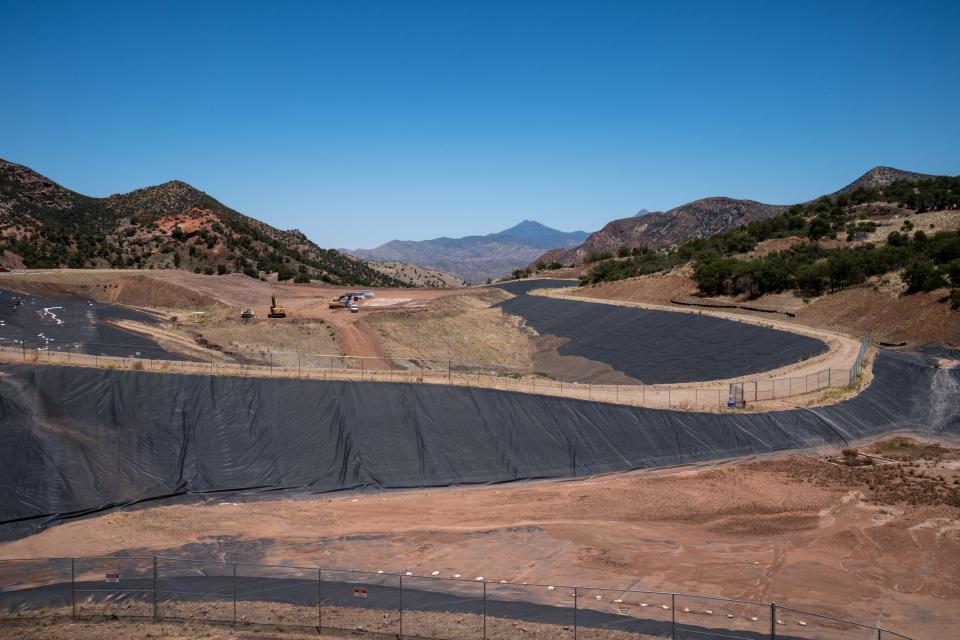
The activity is in an old lead-mining district dating to the 19th century along the saddle divide between two creeks, where the company has built water treatment plants atop both. South32 agreed to clean up the abandoned mess there before extracting minerals that were left behind but now are needed for electrifying the economy.
Through a notch in the Patagonias, the construction site offers views of Mount Wrightson, the highest peak of the Santa Ritas, the next Sky Island in the chain.
Jaguars, black bears and other creatures will find safe passage around this mine and to the Santa Ritas, or south into Mexico, said Pat Risner, president of southern Arizona operations for South32.
“This is an important reason why we’re keeping our footprint small,” Risner said. A biologist for the company added that bridges and culverts along a new access road will be sized to encourage continued migration through the area.
Even if the Hermosa Mine expands to the full extent of claims under as much as 70 square miles of the surrounding public lands, he said, it will do so through a web of tunnels from the shafts now descending from a footprint of just over 1 square mile. The same is true for the company’s nearby Flux Canyon copper find, which Risner said could be reached through the same shaft as the zinc deposit.
The company buses workers to the site to reduce traffic, and most of those who will operate underground machinery will do so remotely from a center in Nogales. The mine will need a new road to truck ore concentrate out for smelting in Mexico, though, as well as a power line from Nogales to enable electric equipment to excavate the ore.
South32 has compiled data and locations of protected species found in the project vicinity, including Mexican spotted owls, yellow-billed cuckoos, Sonoran tiger salamanders and northern goshawks but cannot share that information publicly because federal biologists don’t want people disturbing those animals, Risner said. A public process for permitting activity on the forest will likely reveal some information about species use of the land during the coming year.
El Jefe is evidently living out his retirement in Mexico, but another male jaguar, known as Sombra, has recently taken up residence in the Chiricahuas. While verdant swaths of South America are considered core jaguar habitat, these wanderers of the arid north may be more adaptable and therefore important to survival as the climate changes, said Russ McSpadden, Southwest conservation advocate with the Center for Biological Diversity.
“Jaguars are re-establishing territory on their own, despite all the obstacles,” McSpadden said. “That’s what’s so amazing.”
The mining boom, driven in part by a push to electrify with more domestic copper and other resources, is an unwelcome intrusion into “a recognized biodiversity hotspot” that McSpadden seeks to keep as wild as possible. “The thing that keeps me awake at night is cumulative impacts.”
The federal government is investing in the ecosystem. The Interior Department’s Bureau of Land Management formally recognized the Sky Islands as a biodiversity priority and one of its key restoration landscapes last year when it earmarked $12 million for it, including $9.6 million from the Inflation Reduction Act, the same law that Congress passed to incentivize electric vehicles and other aspects of the energy transition.
The rest comes from the Bipartisan Infrastructure Law. It’s intended to work with partner agencies and nonprofits to improve forest health, remove invasive species such as buffelgrass that promote wildfires, fence cows out of the ribbon of cottonwood forest along the San Pedro River and otherwise maintain pathways between the Sky Islands.
“Because it’s both desert and alpine, there are 30 federally listed species that rely on this landscape,” BLM Director Tracy Stone-Manning told The Arizona Republic in April. “So it just needed some help.”
Help is never in short supply when the Sky Island Alliance’s Lichtenhan leads weekend work crews in the region. Volunteers routinely gush about them, not just as opportunities to preserve their surroundings, but as ecological learning sessions.
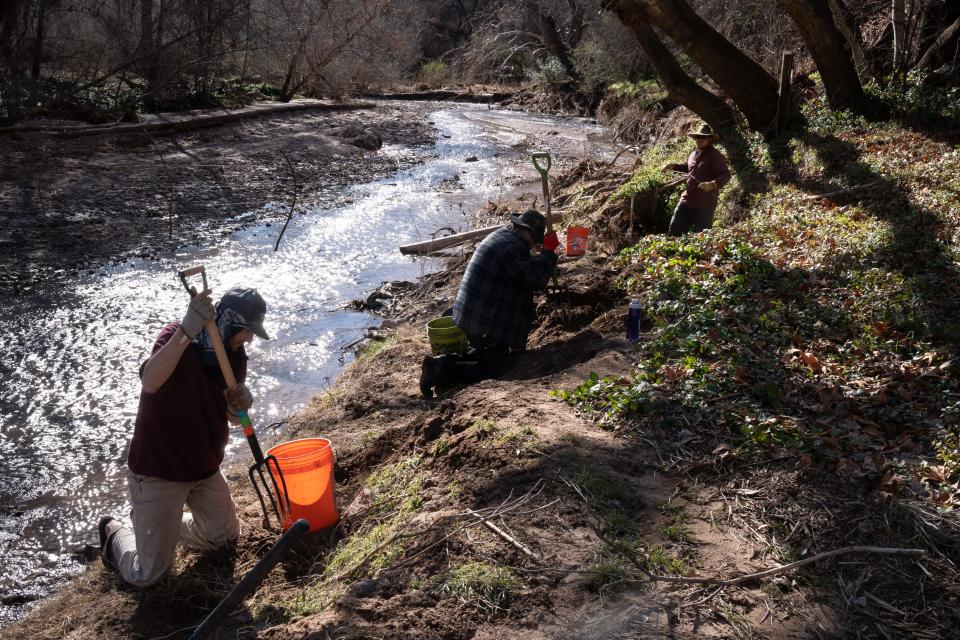
On one outing in Aravaipa Canyon in February 2023, Lichtenhan crouched over a mountain lion track in the streambank sand and demonstrated how to tell the difference between a cat’s print and a coyote’s or dog’s.
More to the point of the day’s work, he told volunteers that the print illustrated how important the canyon and its streamside forest are in providing a wildlife highway from the cliffs of one Sky Island on the south (the Galiuro Range) to another on the north (the Santa Teresa Range).
He had brought the crew there to protect that forest and stream by ripping out thirsty mats of non-native vines that covered the forest floor and if left there would prevent cottonwood seeds from germinating and growing.
The culprit was vinca, an invasive periwinkle settlers may have introduced to stabilize stream banks where they started irrigating. Trouble is it spreads downstream and stabilizes banks too well to support the native trees.
“You get an impoverished ecosystem,” Lichtenhan said. “There’s nothing for (animals) to eat.”
There are plenty of animals to feed: javelinas, black bears, skunks, wild turkeys, deer, coatis, yellow-billed cuckoos, gray hawks and all kinds of other birds. The stream also has Arizona’s most intact native fish community, Lichtenhan said, including spike dace, loach minnow, roundtail chub, Sonoran sucker, Gila topminnow and longfin dace.
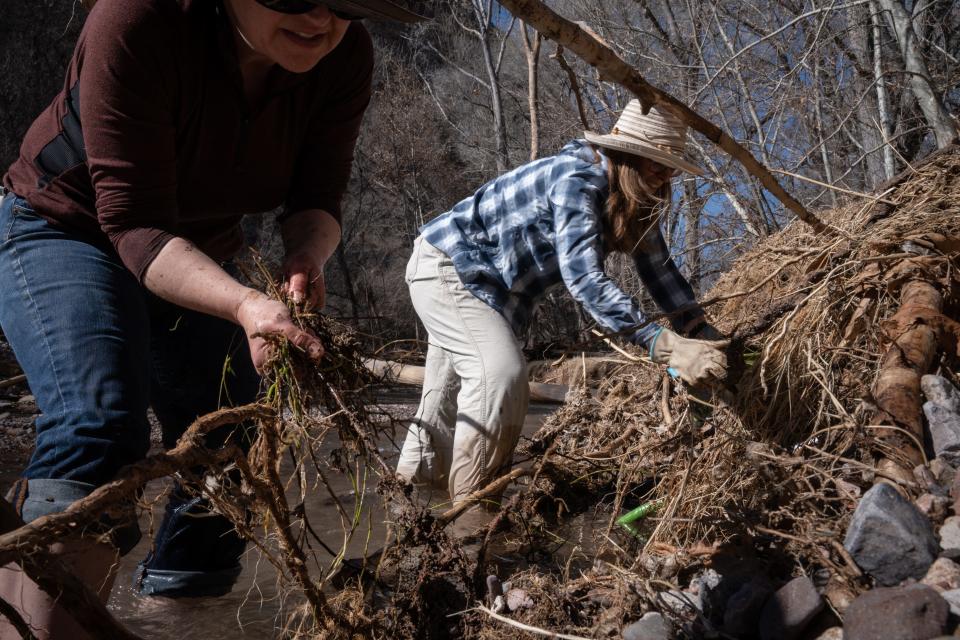
The crew had camped out in the cold at the Nature Conservancy’s property upstream from where Aravaipa heads into federal lands that require a recreational permit. There, along TNC’s reserve, they would dig out the vines by the root and take it away in buckets. Any root left behind would regrow the vines after a monsoon flood.
Sammantha Fabish of Mesa was among several volunteers making a repeat visit to clear periwinkle. The place brims with life, she said, explaining the appeal. Now in her 30s, she only got into the outdoors a few years ago.
“It’s just magical,” she said. “I love that I don’t have cell service. It’s just nice to be out here doing something with your hands and your body for a good cause.”
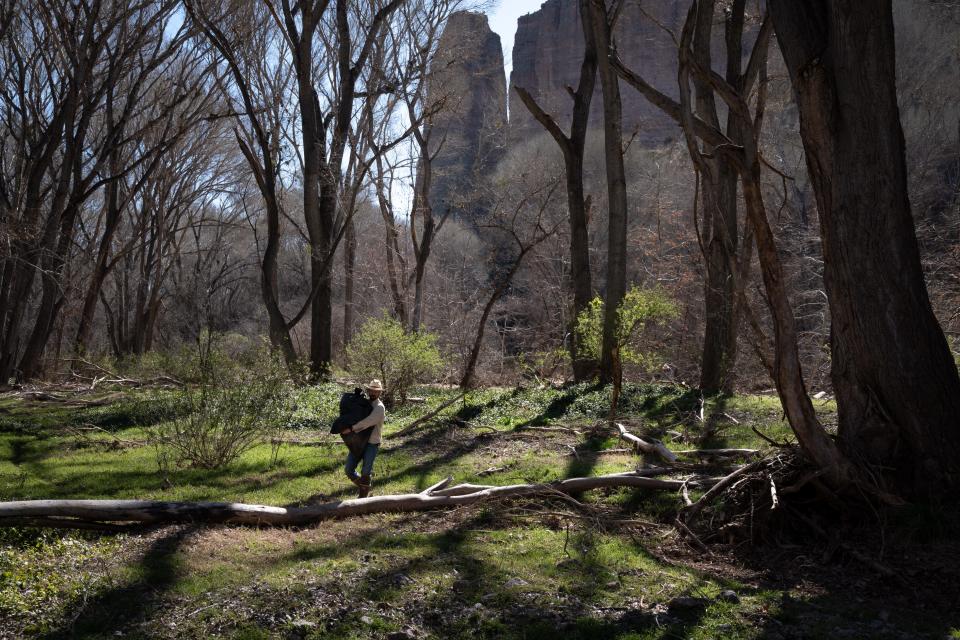
Gathering grounds: The fight to save the islands
Jocelyne Medel brought her 28th birthday party up Mount Lemmon last year to the Alder Picnic Area. She and friends gathered around a picnic table with cups of Southern Comfort and a box of Krispy Kreme doughnuts, some Jimmy John’s sandwiches and Cheetos. Somebody made a snowman from a mid-February blanket of snow.
Just downhill, a couple marched a plastic sled to a spot under the pines where they climbed aboard and then sped down to where the slope steepened and disappeared from view, as if they had launched themselves airborne toward the brown desert thousands of feet below. Moments later they reappeared while marching back to the launch point.
“It’s nice because it’s snowing up here and then we get back to the sun (in Tucson),” Medel said between birthday toasts. Sometimes the snow attracts too much of a crowd, she said.

The snows have always been unpredictable, in recent years especially so. Ski Valley Manager Graham Davies has been here for five decades, having taken over for his dad. Until the snowy winter of 2022-2023, he said, seasons had become spotty. The ski area would open after Christmas, close for lack of snow, reopen when possible, and so on. Several years ago, it never opened during winter. “This is more back to normal,” he said on that snowy February day.
Other things that are increasingly normal: wildfire evacuations and animals typically associated with the desert below, such as roadrunners and javelinas.
It wasn’t ever unheard of to pack up and leave during fire season, said Davies, who grew up on the mountain. But when the big blazes started in this century, they replaced Summerhaven’s small-town ethos, supplanting it with more of a resort vibe.
“Unfortunately it changed the community a lot,” he said. “It became more of a weekend warrior thing.”
To southern Arizona’s original inhabitants, the Sky Islands are a place of healing and life-giving energy. To the south of Mount Lemmon and Tucson, the Santa Rita Mountains are a longtime gathering ground for the Tohono O’odham people. Springs and woodlands that are now under threat from Hudbay’s copper mining claims were once a retreat for warriors after conflicts with Apaches, said Austin Nunez, chairman of the Tohono O’odham Nation’s San Xavier District.
“After battle, our men would go over there to cleanse themselves,” Nunez said. To this day, tribal members pick acorns atop the mountains and saguaro cactus fruit below. The fruit goes into jams and syrups, and is also fermented into a wine for rain ceremonies. “The mountain range is very significant for us,” Nunez said.
So is the Baboquivari Range to the west, whose highest peak he has climbed to be closer to the home of I’itoi, his people’s creator.
“It was just magnificent, he said. “You could see all over,” across southern Arizona and into Mexico.
Besides mines, the warming climate threatens the region’s culture and the environment that supports it, he said.
“Climate change affects all of us,” he said. “If it gets any drier, the animals that would normally be there would likely head farther north, and perhaps also the plants.
“We certainly pray that climate change could be reversed,” Nunez said, “or at least stemmed.”

Apaches revere Mount Graham because it is a female mountain that gives life to animals and people, providing water and acorns, said Nosie, the Apache activist who leads a yearly spiritual run to the mountain.
“It’s an island of its own, (and) takes care of its own,” Nosie said.
Construction of a telescope observatory on top of the mountain, a joint project of the Vatican and the University of Arizona, led to Nosie’s activism there. He sought to block it, and was arrested while praying there in the early 1990s. Apaches visiting the mountain remove all metal or other reflective objects that could repel spirits from visiting the mountain, he said. A telescope’s glass is a problem.
“With the telescope there, it creates a reflection,” he said. “So when something good is coming, it doesn’t make it.”
The run is done in shifts, covering 148 miles. It starts in San Carlos on a Thursday evening, then resumes at 4 a.m., and ends at 2 in the afternoon. Those who participate heed the mountain’s call, Nosie said.
“It’s just like a magnet,” he said. “It just pulls.”
A magnet. That’s a description that fits this one Sky Island, but also all of them. They’re places where people and animals are drawn for refuge, sustenance and solace.
“It’s a special place in the world,” Sky Island Alliance Director Misztal said.
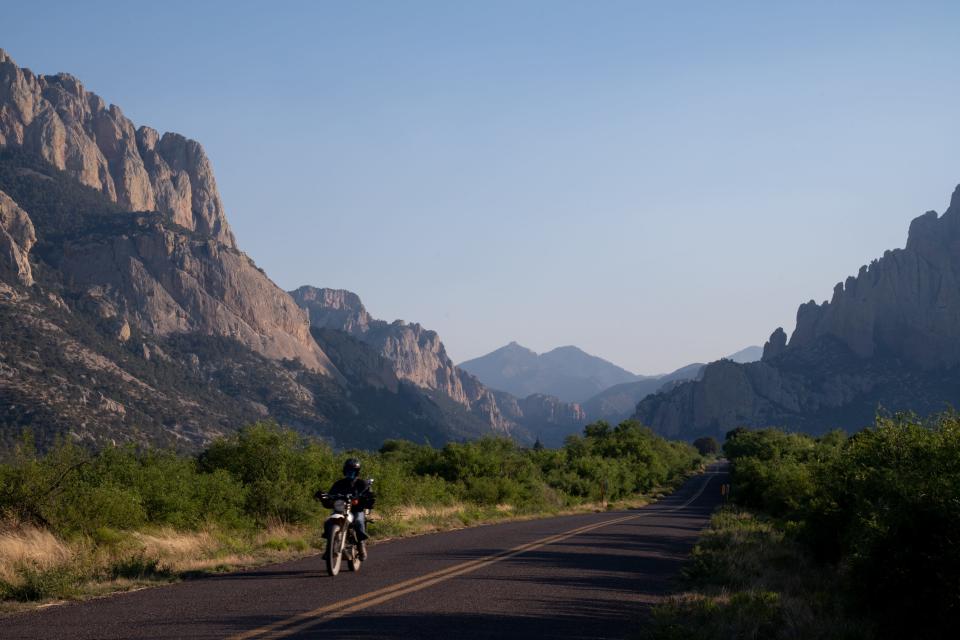
Brandon Loomis covers environmental and climate issues for The Arizona Republic and azcentral.com. Reach him at brandon.loomis@arizonarepublic.com.
Environmental coverage on azcentral.com and in The Arizona Republic is supported by a grant from the Nina Mason Pulliam Charitable Trust.
Sign up for AZ Climate, our weekly environment newsletter, and follow The Republic environmental reporting team at environment.azcentral.com and @azcenvironment on Facebook and Instagram.
You can support environmental journalism in Arizona by subscribing to azcentral.com today.
This article originally appeared on Arizona Republic: Arizona's Sky Islands endangered by climate change, wildfires, mining

